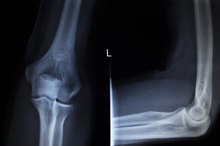Causes of Pain on the Right Side of the Neck Down to the Shoulder
According to the American Academy of Orthopaedic Surgeons, or AAOS, neck pain can be caused by abnormalities in the soft tissues, including the muscles, ligaments and nerves, along with the vertebrae or spinal bones and joints 1. In some cases, neck pain manifests on only one side of the cervical spine and radiates to the upper shoulder area. Neck and shoulder pain can be mild, moderate or severe, depending on the cause of the pain.
If you are experiencing serious medical symptoms, seek emergency treatment immediately.
Whiplash
Whiplash can cause right-sided pain that runs from the neck down to the shoulder. According to the National Institute of Neurological Disorders and Stroke, or NINDS, whiplash is a collection of symptoms that occur immediately after a rapid extension and flexion injury of the neck. In most cases, whiplash involves a neck sprain and strain -- soft tissue injuries that can cause considerable pain or discomfort in one or both sides of the neck, depending on the orientation of the neck during the injury. The most common cause of whiplash is a motor vehicle accident, although the condition can also be caused by sports mishaps.
- Whiplash can cause right-sided pain that runs from the neck down to the shoulder.
- According to the National Institute of Neurological Disorders and Stroke, or NINDS, whiplash is a collection of symptoms that occur immediately after a rapid extension and flexion injury of the neck.
Brachial Plexus Injury
What Are the Causes of Pain, Numbness & Tingling in the Left Arm?
Learn More
A brachial plexus injury can cause pain on the right side of the neck down to the shoulder. Brachial plexus injuries involve damage to the network of nerves -- the brachial plexus -- that send signals from the spine to the shoulder, arm and hand. Brachial plexus injuries occur when these nerves are stretched or torn. Brachial plexus injuries may occur when the head and neck are forcibly moved away from the affected shoulder while the affected shoulder is pressed down, over-stretching the side of the neck and the tissues that run from the upper neck to the top of the shoulder. According to MayoClinic.com, brachial plexus injuries are common in contact sports, but may also occur during motor vehicle accidents and falls. Common signs and symptoms associated with brachial plexus injuries include neck and shoulder pain, an electrical shock-like sensation down the arm and affected-side arm numbness and weakness.
- A brachial plexus injury can cause pain on the right side of the neck down to the shoulder.
- Brachial plexus injuries may occur when the head and neck are forcibly moved away from the affected shoulder while the affected shoulder is pressed down, over-stretching the side of the neck and the tissues that run from the upper neck to the top of the shoulder.
Cervical Disc Herniation
According to the Spine Universe website, a ruptured or herniated cervical disc is a common cause of neck, shoulder and arm pain 2. A cervical disc herniation occurs when the annulus fibrosus -- the fibrous ring that surrounds a spinal disc -- cracks or breaks open, allowing the nucleus pulposus -- the jelly-like center portion of the spinal disc -- to protrude into the spinal canal or the intervertebral foramen. The intervertebral foramen is the hole through which spinal nerve roots -- offshoots of the spinal cord -- exit the spinal column. If the herniated disc material irritates or compresses one of these nerve roots, a person will usually experience pain or discomfort in the neck, shoulder and arm. Along with pain, common signs and symptoms associated with a cervical disc herniation include arm numbness and tingling and weakness in certain arm muscles.
- According to the Spine Universe website, a ruptured or herniated cervical disc is a common cause of neck, shoulder and arm pain 2.
- If the herniated disc material irritates or compresses one of these nerve roots, a person will usually experience pain or discomfort in the neck, shoulder and arm.
Related Articles
References
- American Academy of Orthopaedic Surgeons: Neck Pain
- Spine Universe: Cervical Herniated Disc or Ruptured Disc
- Iyer S, Kim HJ. Cervical radiculopathy. Curr Rev Musculoskelet Med. 2016;9(3):272-280. doi:10.1007/s12178-016-9349-4
- Caridi JM, Pumberger M, Hughes AP. Cervical radiculopathy: a review. HSS J. 2011;7(3):265-272. doi:10.1007/s11420-011-9218-z
- Munakomi S, Foris LA, Varacallo M. Spinal Stenosis and Neurogenic Claudication. Treasure Island, FL: StatPearls Publishing; 2019.
- Curatolo M, Bogduk N, Ivancic PC, McLean SA, Siegmund GP, Winkelstein BA. The role of tissue damage in whiplash-associated disorders: Discussion paper 1. Spine. 2011;36(25 Suppl):S309-S315. doi:10.1097/BRS.0b013e318238842a
- Suvarnnato T, Puntumetakul R, Uthaikhup S, Boucaut R. Effect of specific deep cervical muscle exercises on functional disability, pain intensity, craniovertebral angle, and neck-muscle strength in chronic mechanical neck pain: a randomized controlled trial. J Pain Res. 2019;12:915-925. doi:10.2147/JPR.S190125
- Kim EK, Kim JS. Correlation between rounded shoulder posture, neck disability indices, and degree of forward head posture. J Phys Therapy Sci. 2016;28(10):2929-2932. doi:10.1589/jpts.28.2929
- Burbank KM, Stevenson JH, Czarnecki GR, Dorfman J. Chronic shoulder pain: part I. Evaluation and diagnosis. Am Fam Physician. 2008;77(4):453-460.
- Burbank KM, Stevenson JH, Czarnecki GR, Dorfman J. Chronic shoulder pain: part II. Treatment. Am Fam Physician. 2008;77(4):493-497.
Writer Bio
Martin Hughes is a chiropractic physician, health writer and the co-owner of a website devoted to natural footgear. He writes about health, fitness, diet and lifestyle. Hughes earned his Bachelor of Science in kinesiology at the University of Waterloo and his doctoral degree from Western States Chiropractic College in Portland, Ore.







